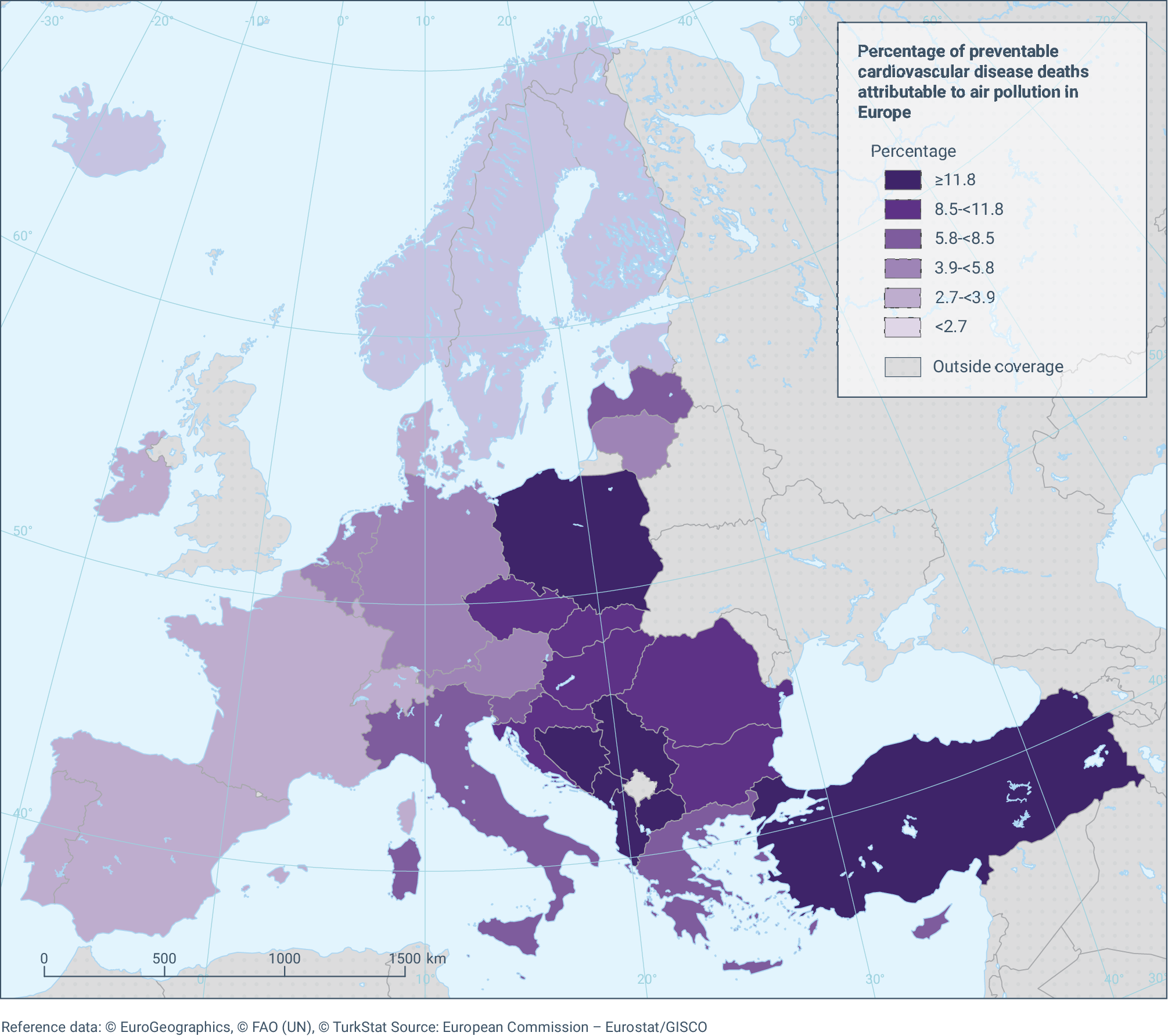Bourdrel, T., et al., 2017, ‘Cardiovascular effects of air pollution’, Archives of Cardiovascular Diseases 110(11), pp. 634-642 (DOI: 10.1016/j.acvd.2017.05.003).
Cesaroni, G., et al., 2014, ‘Long term exposure to ambient air pollution and incidence of acute coronary events: prospective cohort study and meta-analysis in 11 European cohorts from the ESCAPE Project’, BMJ (Clinical research ed.) 348, p. f7412 (DOI: 10.1136/bmj.f7412).
Cohen, A. J., et al., 2017, ‘Estimates and 25-year trends of the global burden of disease attributable to ambient air pollution: an analysis of data from the Global Burden of Diseases Study 2015’, The Lancet 389(10082), pp. 1907-1918 (DOI: 10.1016/S0140-6736(17)30505-6).
Dai, H., et al., 2022, ‘Global, regional, and national burden of ischaemic heart disease and its attributable risk factors, 1990–2017: results from the Global Burden of Disease Study 2017’, European Heart Journal - Quality of Care and Clinical Outcomes 8(1), pp. 50-60 (DOI: 10.1093/ehjqcco/qcaa076).
EC, 2022a, ‘Air quality — existing legislation’, European Commission (https://ec.europa.eu/environment/air/quality/existing_leg.htm).
EC, 2022b, ‘Zero pollution action plan’, European Commission (https://ec.europa.eu/environment/strategy/zero-pollution-action-plan_en).
EEA, 2021a, Air quality in Europe 2021, European Environment Agency (https://www.eea.europa.eu/publications/air-quality-in-europe-2021/).
EEA, 2022b, Europe’s air quality status 2021— update, EEA Briefing (https://www.eea.europa.eu/publications/air-quality-in-europe-2021/air-quality-status-briefing-2021) accessed 22 June 2022.
EU, 2004, Directive 2004/107/EC of the European Parliament and of the Council of 15 December 2004 relating to arsenic, cadmium, mercury, nickel and polycyclic aromatic hydrocarbons in ambient air (OJ L 23, 26.1.2005, pp. 3-16).
EU, 2008, Directive 2008/50/EC of the European Parliament and of the Council of 21 May 2008 on ambient air quality and cleaner air for Europe (OJ L 152, 11.6.2008, p. 1-44).
EU, 2016, Directive 2016/2284/EC of the European Parliament and of the Council of 14 December 2016 on the reduction of national emissions of certain atmospheric pollutants, amending Directive 2003/35/EC and repealing Directive 2001/81/EC (OJ L 344, 17.12.2016, pp. 1-31).
Feigin, V. L., et al., 2021, ‘Global, regional, and national burden of stroke and its risk factors, 1990–2019: a systematic analysis for the Global Burden of Disease Study 2019’, The Lancet Neurology 20(10), pp. 795-820 (DOI: 10.1016/S1474-4422(21)00252-0).
GBD Collaborative Network, 2020, GBD Results Tool, GBD Results Tool., (http://ghdx.healthdata.org/gbd-results-tool), Institute for Health Metrics and Evaluation.
IHME, 2020, ‘Global Burden of Disease data set’, Institute for Health Metrics and Evaluation (https://ghdx.healthdata.org/gbd-results-tool).
Ji, J. S., 2022, ‘Air pollution and cardiovascular disease onset: hours, days, or years?’, The Lancet Public Health 7(11), pp. e890-e891 (DOI: 10.1016/S2468-2667(22)00257-2).
Sang, S., et al., 2022, ‘The global burden of disease attributable to ambient fine particulate matter in 204 countries and territories, 1990-2019: A systematic analysis of the Global Burden of Disease Study 2019’, Ecotoxicology and environmental safety 238, p. 113588 (DOI: 10.1016/j.ecoenv.2022.113588).
Wolf, K., et al., 2021, ‘Long-term exposure to low-level ambient air pollution and incidence of stroke and coronary heart disease: a pooled analysis of six European cohorts within the ELAPSE project’, The Lancet. Planetary health 5(9), pp. e620-e632 (DOI: 10.1016/S2542-5196(21)00195-9).

Document Actions
Share with others